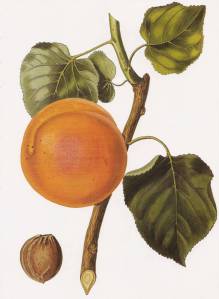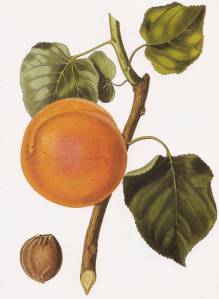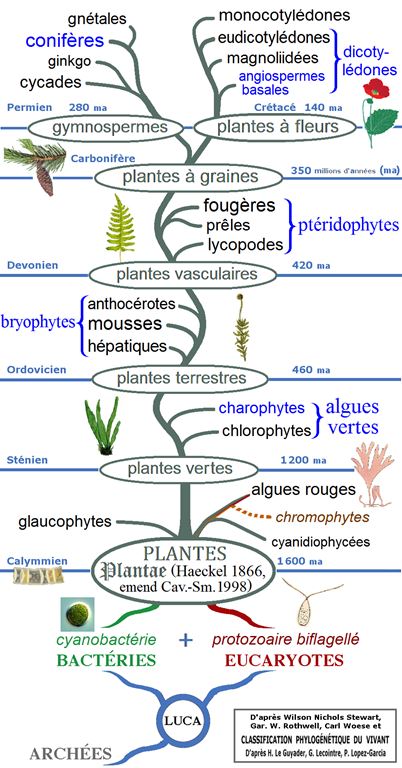Abricotier
(Prunus armeniaca)

Un arbre à feuilles caduques de taille moyenne. Il atteint 10 m de haut. C'est une forme large et étalée. L'écorce est brun-rouge foncé et lisse et brillante. Les feuille ... (traduction automatique)
→suite
Abricotier 
Note alimentaire ![]()
![]()
![]()
Note médicinale ![]()
![]()
![]()
Un arbre à feuilles caduques de taille moyenne. Il atteint 10 m de haut. C'est une forme large et étalée. L'écorce est brun-rouge foncé et lisse et brillante. Les feuilles ont des tiges. Les feuilles sont largement ovales. Ils mesurent 10 cm de long sur 6 cm de large. Ils sont arrondis à la base et se rétréciss... (traduction automatique) →suite
Pas d'autre illustration
pour le moment 😕
Classification
- Classique : en haut de l\'écran, sous le coeur.
- Phylogénétique :
- Clade 4 : Angiospermes ;
- Clade 3 : Dicotylédones_vraies ;
- Clade 2 : Rosidées ;
- Clade 1 : Fabidées ;
- Ordre APN : Rosales ;
- Famille APN : Rosaceae ;
Illustration : cet arbre phylogénétique des plantes montre les principaux clades et groupes traditionnels (monophylétiques en noir et paraphylétiques en bleu).
Dénominations
✖- Nom botanique : Prunus armeniaca L. (1753)
- Synonymes : Armeniaca vulgaris Lam. 1783 [Prunus armeniaca L. var. armeniaca] ;
- Noms anglais et locaux : ansu apricot [var. ansu], apricot , Siberian apricot, Tibetan apricot [var. armeniaca], xing (cn transcrit), ye xing [var. ansu] (cn transcrit), Aprikose (de), Aprikosenbaum (de), Marille (de), anzu [ var. ansu] (jp romaji), salgunamu [var. ansu] (ko transcrit), damasco (pt), damasqueiro (pt), abricó (pt,br), albaricoque (es), damasco (es), damasquino (es), aprikos (sv)
Description et culture
✖- dont infos de "FOOD PLANTS INTERNATIONAL" :
Description :
Un arbre à feuilles caduques de taille moyenne. Il atteint 10 m de haut. C'est une forme large et étalée. L'écorce est brun-rouge foncé et lisse et brillante. Les feuilles ont des tiges. Les feuilles sont largement ovales. Ils mesurent 10 cm de long sur 6 cm de large. Ils sont arrondis à la base et se rétrécissent vers la pointe. Ils ont des dents rondes peu profondes le long du bord. Les feuilles sont brillantes et vert foncé. Les fleurs mesurent 2,5 cm de diamètre et sont rose pâle ou blanches. Ils sont presque sans tiges et ont 5 pétales. Ils se produisent individuellement sur les vieilles pousses. Le fruit est charnu et rond. Il est jaune et peut être rincé de rouge. Il y a un revêtement dur sur la graine. Cette pierre est lisse. Les graines sont ovales. La chair est comestible. Les graines sont comestibles{{{0(+x) (traduction automatique).
Original : A medium sized deciduous tree. It grows 10 m tall. It is a broad spreading shape. The bark is dark red-brown and smooth and shiny. The leaves have stalks. The leaves are broadly oval. They are 10 cm long by 6 cm wide. They are rounded at the base and taper to the tip. They have shallow round teeth along the edge. The leaves are glossy and dark green. The flowers are 2.5 cm across and pale pink or white. They are almost without stalks and have 5 petals. They occur singly on old shoots. The fruit is fleshy and rounded. It is yellow and can be flushed with red. There is a hard covering over the seed. This stone is smooth. The seeds are oval. The flesh is edible. The seeds are edible{{{0(+x).
Production :
Les fruits des arbres sont de 3-4 ans. Les fruits sont cueillis à la main{{{0(+x) (traduction automatique).
Original : Trees fruit is 3-4 years. Fruit are picked by hand{{{0(+x).
Culture :
Les plantes sont cultivées à partir de graines. Les fleurs sont autofertiles. Les plantes nécessitent un certain refroidissement hivernal. {{{0(+x) (traduction automatique).
Original : Plants are grown from seed. The flowers are self fertile. Plants require some winter chilling{{{0(+x).
 Consommation (rapports de comestibilité, parties utilisables et usages alimentaires correspondants)
Consommation (rapports de comestibilité, parties utilisables et usages alimentaires correspondants)
✖
Partie(s) comestible(s){{{0(+x) : fruit, noyaux, graines, noix{{{0(+x).
Utilisation(s)/usage(s){{{0(+x) culinaire(s) :
-le fruit mûr est mangé ;
-les graines peuvent être consommées ; si elles sont douces, elles sont consommées fraîches, et si elles sont amères, elles sont grillées ;
-l'huile des graines est utilisée pour la cuisson ;
-les fruits sont également utilisés pour les jus et sont séchés et mangés secs ;
-ils sont également utilisés pour la confiture, et dans les pâtisseries, tartes, gâteaux/cakes, et picklés{{{0(+x).(1*)
Partie testée :
fruits crus{{{0(+x) (traduction automatique). Original : Fruit raw{{{0(+x)| Taux d'humidité | Énergie (kj) | Énergie (kcal) | Protéines (g) |
|---|---|---|---|
| 86.6 | 117 | 28 | 0.6 |
| Pro- vitamines A (µg) |
Vitamines C (mg) | Fer (mg) | Zinc (mg) |
| 1500 | 7 | 0.4 | 0.1 |
 Risques et précautions à prendre
Risques et précautions à prendre
✖
néant, inconnus ou indéterminés.
Galerie(s)
✖
Par Bernard M. (domaine public), via Wikimedia Commons
Autres infos
✖dont infos de "FOOD PLANTS INTERNATIONAL" :
Statut :
C'est un arbre fruitier cultivé. Il est vendu sur les marchés locaux et mondiaux{{{0(+x) (traduction automatique).
Original : It is a cultivated fruit tree. It is sold in local and global markets{{{0(+x).
Distribution :
C'est une plante tempérée. Il est originaire d'Asie centrale et de Chine du Nord. Il pousse dans les régions fraîches avec des étés chauds et secs. Ils font mieux sur un sol drainant librement. Au Népal, les plantes poussent entre 2500 et 3500 m d'altitude. Il se porte bien dans les régions avec 100 cm de pluie, des hivers frais avec 300-900 heures de froid en dessous de 7 ° C et un printemps sans gel. Un pH de 6-6,8 convient. Il a besoin d'une bonne lumière du soleil. Il convient aux zones de rusticité 5-10{{{0(+x) (traduction automatique).
Original : It is a temperate plant. It is native to C. Asia and N. China. It grows in cool areas with hot dry summers. They do best on a free draining soil. In Nepal plants grow between 2500-3500 m altitude. It does well in areas with 100 cm rainfall, cool winters with 300-900 chilling hours below 7°C and frost free spring. A pH of 6-6.8 is suitable. It needs good sunlight. It suits hardiness zones 5-10{{{0(+x).
Localisation :
Afghanistan, Afrique, Arabie, Argentine, Arménie, Asie, Australie, Azerbaïdjan, Brésil, Grande-Bretagne, Bulgarie, Canada, Caucase, Asie centrale, Chili, Chine *, Afrique de l'Est, Égypte, Europe, France, Géorgie, Grèce, Himalaya, Hongrie Inde, Indochine, Indonésie, Iran, Irak, Italie, Japon, Corée, Kazakhstan, Kurdistan, Kirghizistan, Lituanie, Macédoine, Malawi, Malaisie, Méditerranée, Mexique, Moldavie, Mongolie, Maroc, Myanmar, Népal, Afrique du Nord, Amérique du Nord , Inde du Nord-Est, Inde du Nord-Ouest, Pakistan, Roumanie, Russie, Asie du Sud-Est, Serbie, Sibérie *, Afrique du Sud, Afrique australe, Amérique du Sud, Espagne, Suisse, Syrie, Tadjikistan, Thaïlande, Turkestan, Turquie, Turkménistan, Tasmanie, USA, Ouzbékistan, Vietnam, Zimbabwe{{{0(+x) (traduction automatique).
Original : Afghanistan, Africa, Arabia, Argentina, Armenia, Asia, Australia, Azerbaijan, Brazil, Britain, Bulgaria, Canada, Caucasus, Central Asia, Chile, China*, East Africa, Egypt, Europe, France, Georgia, Greece, Himalayas, Hungary, India, Indochina, Indonesia, Iran, Iraq, Italy, Japan, Korea, Kazakhstan, Kurdistan, Kyrgyzstan, Lithuania, Macedonia, Malawi, Malaysia, Mediterranean, Mexico, Moldova, Mongolia, Morocco, Myanmar, Nepal, North Africa, North America, Northeastern India, NW India, Pakistan, Romania, Russia, SE Asia, Serbia, Siberia*, South Africa, Southern Africa, South America, Spain, Switzerland, Syria, Tajikistan, Thailand, Turkestan, Turkey, Turkmenistan, Tasmania, USA, Uzbekistan, Vietnam, Zimbabwe{{{0(+x).
Notes :
Il existe environ 200 espèces de Prunus{{{0(+x) (traduction automatique).
Original : There are about 200 Prunus species{{{0(+x).
Liens, sources et/ou références
✖Sources et/ou références :
Jardin! L'Encyclopédie ; Wikipedia ; 5"Plants For A Future" (en anglais) ;
dont classification : "The Plant List" (en anglais) ; "GRIN" (en anglais) ;
dont livres et bases de données : 0"Food Plants International" (en anglais) ;
Le Truffaut du Potager (collectif, éditions Larousse, 2010) / détails du livre
dont biographie/références de "FOOD PLANTS INTERNATIONAL" :
Ambasta, S.P. (Ed.), 2000, The Useful Plants of India. CSIR India. p 494 ; Battacharyya, A., 1991, Ethnobotanical Observations in the Ladakh Region of Northern Jammu and Kashmir State, India. Economic Botany, Vol. 45, No. 3, pp. 305-308 ; Blamey, M and Grey-Wilson, C., 2005, Wild flowers of the Mediterranean. A & C Black London. p 77 ; Bodkin, F., 1991, Encyclopedia Botanica. Cornstalk publishing, p 840 ; Bremness, L., 1994, Herbs. Collins Eyewitness Handbooks. Harper Collins. p 76 ; Coombes, A.J., 2000, Trees. Dorling Kindersley Handbooks. p 258 ; Cundall, P., (ed.), 2004, Gardening Australia: flora: the gardener's bible. ABC Books. p 1092 ; DARLINGTON & AMMAL, ; Dashorst, G.R.M., and Jessop, J.P., 1998, Plants of the Adelaide Plains & Hills. Botanic Gardens of Adelaide and State Herbarium. p 74 ; Dzhangaliev, A. D., et al, 2003, The Wild Fruit and Nut Plants of Kazakhstan, Horticultural Reviews, Vol. 29. pp 305-371 ; Facciola, S., 1998, Cornucopia 2: a Source Book of Edible Plants. Kampong Publications, p 194 (As Armeniaca vulgaris) ; Flowerdew, B., 2000, Complete Fruit Book. Kyle Cathie Ltd., London. p 40 ; Hu, Shiu-ying, 2005, Food Plants of China. The Chinese University Press. p 441 ; Glowinski, L., 1999, The Complete Book of Fruit Growing in Australia. Lothian. p 74 ; GUPTA, ; Hedrick, U.P., 1919, (Ed.), Sturtevant's edible plants of the world. p 519 ; Hibbert, M., 2002, The Aussie Plant Finder 2002, Florilegium. p 240 ; Jackes, D. A., 2007, Edible Forest Gardens ; Jardin, C., 1970, List of Foods Used In Africa, FAO Nutrition Information Document Series No 2.p 156 ; John, L., & Stevenson, V., 1979, The Complete Book of Fruit. Angus & Robertson p 57 ; Kang, Y., et al, 2012, Wild food plants and wild edible fungi in two valleys on the Qinling Mountains (Shaanxi, central China) Journal of Ethnobiology and Ethnomedicine; 9:26 ; Lazarides, M. & Hince, B., 1993, Handbook of Economic Plants of Australia, CSIRO. p 199 ; Lord, E.E., & Willis, J.H., 1999, Shrubs and Trees for Australian gardens. Lothian. p 66 ; Lorenzi, H., Bacher, L., Lacerda, M. & Sartori, S., 2006, Brazilian Fruits & Cultivated Exotics. Sao Paulo, Instituto Plantarum de Estuados da Flora Ltda. p 496 ; Macmillan, H.F. (Revised Barlow, H.S., et al) 1991, Tropical Planting and Gardening. Sixth edition. Malayan Nature Society. Kuala Lumpur. p 317 ; Manandhar, N.P., 2002, Plants and People of Nepal. Timber Press. Portland, Oregon. p 382 ; Menninger, E.A., 1977, Edible Nuts of the World. Horticultural Books. Florida p 58 ; Moerman, D. F., 2010, Native American Ethnobotany. Timber Press. p 440 ; Morley, B. & Everard, B., 1970, Wild Flowers of the World. Ebury press. Plate 45 ; Pham-Hoang Ho, 1999, An Illustrated Flora of Vietnam. Nha Xuat Ban Tre. p 805 ; Plants For A Future database, The Field, Penpol, Lostwithiel, Cornwall, PL22 0NG, UK. https://www.scs.leeds.ac.uk/pfaf/ ; Polunin, O., & Stainton, A., 2006, Flowers of the Himalaya, Oxford India Paperbacks. p 114 ; PROSEA No. 2 ; Rana, J.C. et al, 2011, Genetic resources of wild edible plants and their uses among tribal communities of cold arid regions of India. Genetic Resources and Crop Evolution. 59:135-149 ; Rashid, A., Anand, V.K. & Serwar, J., 2008, Less Known Wild Plants Used by the Gujjar Tribe of District Rajouri, Jammu and Kashmir State. International Journal of Botany 4(2):219-244 ; Sharma, B.B., 2005, Growing fruits and vegetables. Publications Division. Ministry of Information and broadcasting. India. p 16 ; Solomon, C., 2001, Encyclopedia of Asian Food. New Holland. p 94 ; Sp. pl. 1:474. 1753 ; Valder, P., 1999, The Garden Plants of China. Florilegium. p 102 ; van Wyk, B., 2005, Food Plants of the World. An illustrated guide. Timber press. p 305 ; Watkins, R., 1979, Cherry, plum, peach, apricot and almond, in Simmonds, N.W., (ed), Crop Plant Evolution. Longmans. London. p 242 ; Wickens, G.E., 1995, Edible Nuts. FAO Non-wood forest products. FAO, Rome. p147 ; Williamson, J., 2005, Useful Plants of Malawi. 3rd. Edition. Mdadzi Book Trust. p 208
Recherche de/pour :
- "Prunus armeniaca" sur Google (pages et
images) ;
TROPICOS (en anglais) ;
Tela Botanica ;
Pl@ntNet ;
Pl@ntUse ;
- "Abricotier" sur Google (pages, images et recettes) ;
- "Prunus armeniaca" sur Google (pages et
images) ;
TROPICOS (en anglais) ;
Tela Botanica ;
Pl@ntNet ;
Pl@ntUse ;
Sous-espèces, variétes...
✖2 taxons
Espèces du même genre (Prunus)
✖50 taxons (sur 174)
- Prunus afghana
- Prunus africana (Hook.f.) Kalkman
- Prunus alabamensis
- Prunus alleghaniensis
- Prunus amareno
- Prunus americana Marshall (Prunier américain)
- Prunus andersonii
- Prunus angustifolia Marshall (Prunier chicachas)
- Prunus apetala
- Prunus arabica
- Prunus armeniaca L. (Abricotier)
- Prunus avium (L.) L. (Merisier)
- Prunus barbata
- Prunus besseriana
- Prunus besseyi L.H.Bailey
- Prunus bifrons
- Prunus bokhariensis
- Prunus bracteopadus
- Prunus brigantina Vill. (Prunier de Briançon)
- Prunus bucharica
- Prunus buergeriana
- Prunus campanulata
- Prunus canescens
- Prunus capollin
- Prunus capsica
- Prunus carmesina
- Prunus caroliniana
- Prunus cerasifera Ehrh. (Prunier myrobalan)
- Prunus cerasifera x Prunus salicina
- Prunus cerasoides
- Prunus cerasus L. (Griottier)
- Prunus cocomilia
- Prunus consociiflora C.K.Schneid.
- Prunus cornuta
- Prunus cortapico
- Prunus davidiana
- Prunus dawyckensis
- Prunus demissa
- Prunus depressa
- Prunus dielsiana
- Prunus divaricata
- Prunus domestica L. (Prunier)
- Prunus dulcis (Mill.) DAWebb (Amandier)
- Prunus edentata
- Prunus emarginata
- Prunus fasciculata
- Prunus fenzliana
- Prunus ferganensis
- Prunus fruticans
- Prunus fruticosa
- ...
Espèces de la même famille (Rosaceae)
✖50 taxons (sur 1223)
- Acaena anserinifolia (Forst. & Forst.f.) Druce
- Agrimonia coreana
- Agrimonia eupatoria L. (Aigremoine eupatoire)
- Agrimonia odorata
- Agrimonia pilosa
- Alchemilla alpina
- Alchemilla conjuncta
- Alchemilla fissa
- Alchemilla glabra
- Alchemilla hybrida
- Alchemilla mollis
- Alchemilla plicatula
- Alchemilla splendens
- Alchemilla vulgaris L. (Alchémille commune)
- Alchemilla xanthoclora
- Amelanchier alnifolia (Nutt.) Nutt. ex M. Roem. (Amélanchier à feuilles d'aulne)
- Amelanchier amabilis
- Amelanchier arborea
- Amelanchier asiatica
- Amelanchier bartramiana
- Amelanchier basalticola
- Amelanchier canadensis (L.) Medik. (Amélanchier du canada)
- Amelanchier confusa
- Amelanchier cretica
- Amelanchier cusickii
- Amelanchier humilis
- Amelanchier huroensis
- Amelanchier interior
- Amelanchier intermedia
- Amelanchier laevis Wiegand (Amélanchier glabre)
- Amelanchier lamarckii F. G. Schroed. (Amélanchier de lamarck)
- Amelanchier oblongifolia
- Amelanchier obovalis
- Amelanchier obovata
- Amelanchier ovalis Medik. (Amélanchier à feuilles ovales)
- Amelanchier pallida
- Amelanchier parviflora
- Amelanchier pumila
- Amelanchier sanguinea
- Amelanchier spicata
- Amelanchier stolonifera Wiegand
- Amelanchier utahensis
- Amelanchier weigandii
- Amelanchier x grandiflora Rehder
- Amelanchier x grandiflora
- Amelasorbus jackii
- Amygdalus andersonii
- Amygdalus communis
- Amygdalus graeca
- Amygdalus lycioides
- ...


